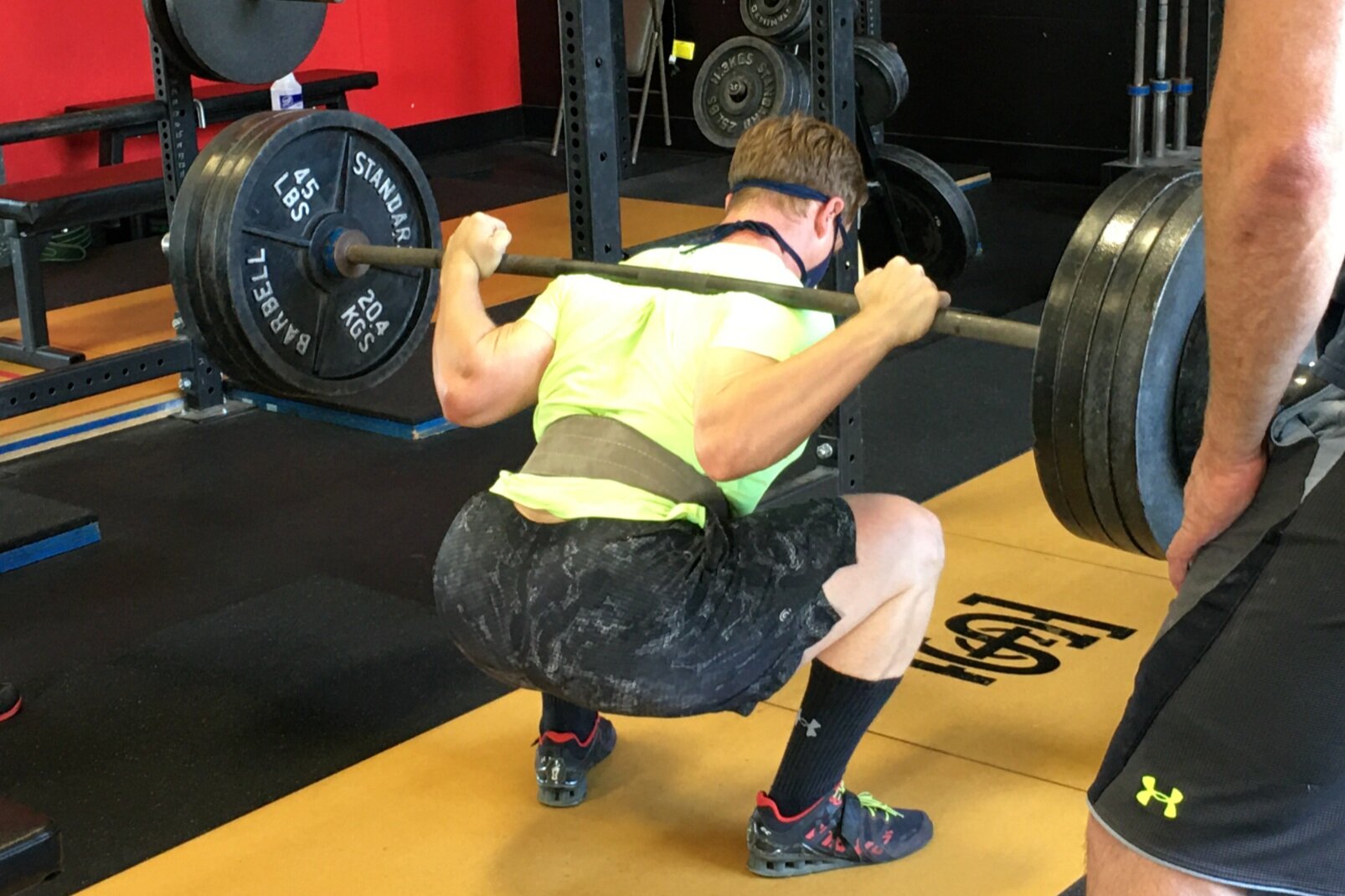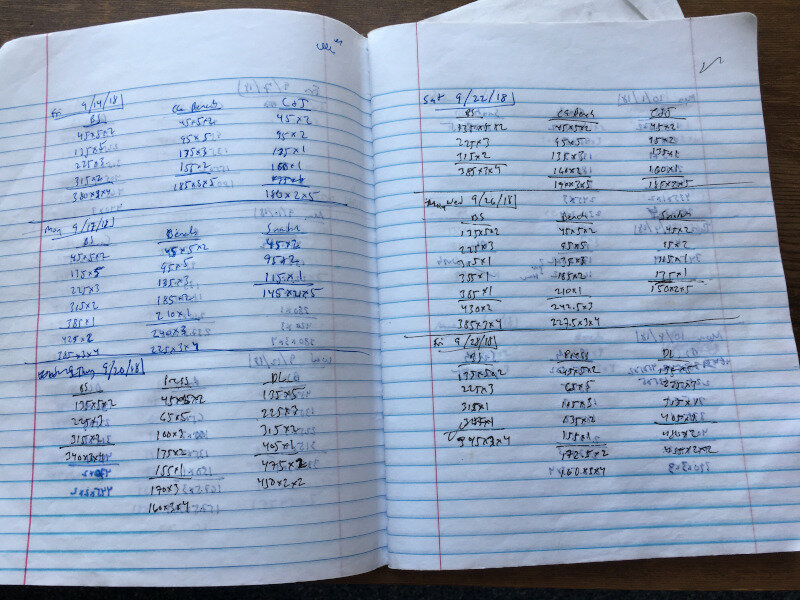Week 2020.09.07
/Reminder: The gym will be closed on Monday, 09/07/20, in observance of Labor Day.
New on the Testify YouTube channel!
This Week’s Conditioning
Option 1
Sled
Outdoors:
10-20 x 25 yds EMOM at a weight of your choice
Every minute, push the sled 25 yards, i.e., if pushing the sled takes 20 seconds, then you have 40 seconds to rest. Perform 10-20 rounds.
Indoors:
10-20 x 100 ft EMOM at a weight of your choice
Every minute, push the sled 100 feet, i.e., if pushing the sled takes 20 seconds, then you have 40 seconds to rest. Perform 10-20 rounds.
Compare to 2020.07.27.
Option 2
Bike/Row for 9 rounds:
1 min on
1 min off
Record distance for each round.
Compare to 2020.07.13.
Option 3
Outdoors:
10 rounds:
25 yd yoke carry
Rest 1 minute
Indoors:
10 rounds:
30 yd yoke carry (15 yd down-back)
Rest 1 minute
Compare to 2020.06.15.
Option 4
10 x 50 ft farmer carry
Each carry is 25 ft down and 25 ft back and is for time. Rest 1 minute between carries.
Women: 97# per handle (80# of plates)
Men: 137# per handle (120# of plates)
(Note: Each handle weighs 17#.)
Compare to 2020.06.08.
Your Training Log - Part 2: How to Keep One
/In last week’s article, Your Training Log - Part 1: Just Do It, we covered the importance of keeping a training log. Now that you’re utterly and forever convinced of the wisdom of keeping a training log, let’s discuss how to keep one. Your log needs to contain several basic elements organized in a readable fashion, but it’s not a complicated process. Grab a plain old composition notebook, and let’s get started.
First, give each week its own page. We tend to think and plan in these chunks called weeks anyway, so it makes sense to organize our training log this way as well. If you complete all your training for a given week and you have extra space at the bottom of the page, don’t be tempted to start another week on the same page. Again, each week gets its own page - no matter what - so start a new page every time you start a new week. The blank space on the preceding page will remind you that you didn’t do your job last week, and hopefully, this will compel you to do better this week.
At the beginning of the week, divide your new page according to the number of days you train per week. For example, if you train three days per week, you’ll divide the page into three sections (horizontally or vertically - either will work). You can and will fit three or four days of training (even five!) onto one page, and allocating a specific amount of space to each day at the beginning of the week will ensure that you color inside the lines.
When training, label each lift, e.g., squat, press, deadlift, snatch, etc. Abbreviations are fine, but you need to be able to go back and understand what you’re written, so don’t get too clever there, Copernicus.
Next, write the goal - the prescription - for the lift you’re about to perform. If you’re planning to squat three sets of five reps for your work sets today, then simply write “3 x 5.” After that, write out your warm-ups and your work sets (remember, reps are always written second), and finally, write out what you’re going to lift next time. Here’s an example:
Squat
3 x 5 Today’s goal
----------
45 x 5 x 2
95 x 5 x 1
135 x 3 x 1 Warm-up sets
185 x 2 x 1
215 x 1 x 1
----------
240 x 5 x 3 Work sets
Next: 245
If you’re only doing one set of something, the “1” for the number of sets is optional (remember multiplying by “1” in school?), so you can leave that part out if you like. In that case, it looks like this:
Squat
3 x 5 Today’s goal
----------
45 x 5 x 2
95 x 5
135 x 3 Warm-up sets
185 x 2
215 x 1
----------
240 x 5 x 3 Work sets
Next: 245
Beyond this, you’ll also want to write down cues that you’re using or will use next time (“Midfoot!”), reminders (“Next time, put belt on for last warm-up and all work sets”), and even how the training session went (“Smoked it today!”). Keeping a PR sheet somewhere in your training log is also a great idea, and perhaps we’ll cover that in a future article.
Of course, you can keep a training log anyway you want to, but this is my article, so you’re getting my recommendations. If you’d like to do it differently, that’s fine . . . just don’t tell me.
Week 2020.08.31
/A big thank you goes out to everyone who competed, helped out, and showed up to cheer on the athletes at this year’s Testify Strongman Summer Showdown!
Reminder: Please note that the gym will be closed on Monday, 09/07/20, in observance of Labor Day.
New on the Testify YouTube channel!
This Week’s Conditioning
Option 1
Sled
Outdoors:
10 rounds of:
Push sled 100 ft
Pull sled 100 ft (hand over hand)
Indoors:
20 rounds of:
Push sled 50 ft
Pull sled 50 ft (hand over hand)
Compare to 2020.07.20.
Option 2
Bike/row:
3 rounds of:
8 x 20 sec on/40 sec off
Rest 3 min between rounds
Score = lowest distance
Compare to 2020.07.06.
Option 3
Outdoors:
5-10 rounds:
10 sledgehammer strikes (5R, 5L)
50 yd farmer carry (25 yd down-back)
Rest 1 minute
Indoors:
5-10 rounds:
10 sledgehammer strikes (5R, 5L)
100 ft farmer carry (50 ft down-back)
Rest 1 minute
Compare to 2020.06.08.
Option 4
Sandbag-over-bars
Set yoke at #33 for women or #35 for men.
1. 1 minute AMRAP
2. 5 rounds of 2 reps every 2 minutes (speed!)
3. 1 minute AMRAP
Weights
Female under 40 years
140 lbs and under: 75 lbs
140.1 lbs – 185 lbs: 100 lbs
185.1 lbs and over: 150 lbs
Female 40 years and over
140 lbs and under: 50 lbs
185 lbs and under: 75 lbs
185.1 lbs and over: 100 lbs
Male under 40 years
185 lbs and under: 150 lbs
185.1 lbs – 235 lbs: 200 lbs
235.1 lbs and over: 250 lbs
Male 40 years and over
185 lbs and under: 100 lbs
185.1 lbs – 235 lbs: 150 lbs
235.1 lbs and over: 200 lbs
Compare to 2020.06.01.
Your Training Log - Part 1: Just Do It
/I was having a conversation with one of our members the other day (you know - not this day, but the other one), and this member - let’s call him Bill - had come upon a startling revelation. Bill had recently gone through several workouts without using his training log, and when he started using it again, he immediately realized that not using his training log had been a huge mistake. He realized that - without the log - his lifting had been unfocused, and the weights were often incorrect. Bill even asked me to never let him get away with that again. Bill is a wise man.
When we train with weights, we do exactly that – we train. Training has a purpose - a goal in mind. To achieve these purposes, to work toward these goals, we need data, and this is where the training log comes in. Without the log (or journal, notebook, etc.), we quickly find ourselves adrift in a sea of barbells and weights with no direction whatsoever. We find ourselves lost in the Sea of Exercise . . . and there be monsters.
Mind you, there is nothing wrong with Exercise, and it's certainly better than Doing Nothing, but let us not confuse Exercise with Training. Exercise is what you do when you want to get hot and sweaty and tired and feel like you’ve accomplished something. Training is how you actually accomplish something. The log separates Training from Exercise.
The log is our history - it tells us where we've been, what we've done - our lifts, warm-up sets, work sets. But it is a more complete history than this - it also includes PRs, how we felt on certain days, how proud we were of our accomplishments, how utterly disappointed we were with our failures. If you had a poopy day squatting 185 lbs for your work sets, write it down in your training log (seriously . . . “this was a poopy day”). Success is magnified by knowing how far we’ve come, and on the day when 185 lbs becomes your second-to-last warm-up set (and that day will come), the knowledge that this weight used to be terribly heavy will remind you of the progress you’ve made.
The log is also our compass - it tells us where we’re going. We write down the weights for our next workout, yes, but we also write down our plans and our goals. I want to bench press three plates. I’m gonna deadlift 250 lbs at the next meet. I WILL get my first pull-up this year. Write this stuff down. All of it. Write down the date on which you set that goal. Someday, you’ll reach that goal, cross it out . . . and set another one.
Don’t kid yourself. If you want to exercise, go right ahead - you’ve got plenty of options. But if you want to put in the hard work of actually training, keep a log. You’ll thank me later, and your coach won’t lose his or her mind when you can’t remember what you’re supposed to squat today.
Next time . . . how to keep a training log (hint: it’s not complicated).
Week 2020.08.24
/Upcoming Events!!
This Saturday (08/29/20), we are hosting the 4th annual Testify Strongman Summer Showdown, so come on out to cheer on your friends (or enemies?)!
Due to the strongman competition, the gym will be closed for training this Saturday.
After the strongman competition, we’re having pulled pork and other goodies, so stick around and join us for some more fun and some great beer brewed by our very own Chas!
New videos on the Testify YouTube channel:
This Week’s Conditioning
Option 1
Sled Pyramid – 4, 5, or 6 tiers
Go up and down a 4, 5, or 6 tier “sled pyramid” – rest as needed. The distance for each round is 80 m indoors (a down-back on the 40m course) or 200 ft outdoors (2 down-backs on the 50 ft course). Rest as needed.
For example, Bob does the following (4 tiers):
Round 1: Empty sled
Round 2: 25#
Round 3: 50#
Round 4: 75#
Round 5: 50#
Round 6: 25#
Round 7: Empty sled
Compare to 2020.07.13.
Option 2
Bike/row:
12 min TT
Score = distance
Compare to 2020.06.29.
Option 3
5-10 rounds of:
30 sec ME tire flips
30 sec rest
Compare to 2020.06.01.
Option 4
1. 5 yoke carries @ 30 yd (15 yd downback) – work up to heaviest carry
2. 5 rounds of 5 reps on the axle “clean and press away” – work up to heavy set of 5
Compare to 2020.05.25.






